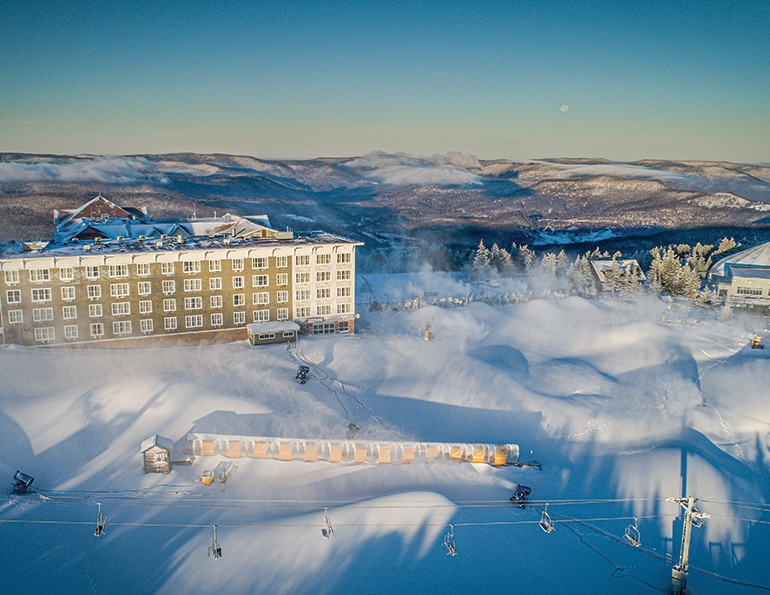I remember sliding down Cupp Run at Snowshoe Mountain, W.Va.—not on skis, but on my back, desperately attempting to arrest my fall on the resort’s steepest run. I was making snow for the second time in my life. Not as a snowmaker. I was a finance guy at the time (winter 2016-17), trying to understand snowmaking and only just realizing what I had gotten myself into.
I was leading a robust assessment of snowmaking effectiveness and efficiency at Snowshoe, aided by several industry experts and my teammates. We studied and analyzed every facet of data imaginable, on paper and on the ground, then modeled and applied the data against a business strategy, and validated it with some deep operational and financial analysis.
I documented the results of the analysis in a 112-page paper, which I then used to craft and propose a $4 million snowmaking system upgrade at Snowshoe. The paper is now often used internally whenever an Alterra-owned resort undertakes a major snowmaking planning initiative.
It was an exhaustive and revealing process through which we gained a better understanding of how to approach snowmaking—and snowmaking master planning—from a business perspective. There are several key elements to this that are important for any ski area owner or operator to understand, whether you’re preparing to master plan a snowmaking system or simply operate one effectively and efficiently.
SNOW BUSINESS
We make snow to sell it—through lift tickets, food, skis, goggles, room nights, and ultimately, experiences. The simple concept of snowmaking as a business-driver of the bottom line should be paramount, but is sometimes forgotten in favor of tradition and routine. Snowmaking must be a forward-looking business pursuit.
A resort’s business plan should drive its snowmaking master plan. How you make snow, how much you make, where and when you make it, and at what cost—i.e., financial cost and opportunity cost—are all factors that should support the business plan.
Translate operations to business strategy. Operationally, ski areas are no strangers to questions like: Which trails should we focus on first? Do we have the right equipment on these trails? When should we start and stop production on these trails and move on to others? These are the right questions to ask, but the answers are often assumed rather than analyzed, usually because the resort has “always done it that way.”
These questions should instead elicit other snowmaking questions directly related to the resort’s business plan, such as: What do guests want, and what will convince them that their early season experience here is worthwhile?
What are our main business risks and constraints, from a snowmaking perspective, and how can we address those?
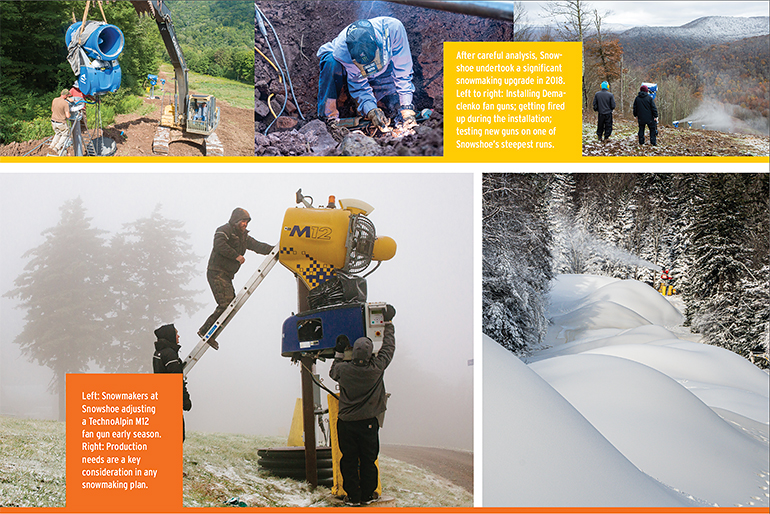
How do we ensure a seamless guest experience? Should we focus on getting on-mountain lodges activated and connected? What quality of learning experience are we offering?
Why before how. Questions like these are part of an envisioning process that establishes the “why” prior to the “how,” allowing you to craft a snowmaking strategy and master plan your system to directly support the resort’s business plan.
Once you’ve determined strategy—opening sequence priorities, etc.—the “how” begins to fall into place with respect to snowmaking master plans or system upgrades. With business objectives and trail opening targets, we can easily understand total water, air, and electrical requirements and begin planning out how much of each we need to serve the business plan.
Then, we can start putting together the pieces of the puzzle (technical, engineering, equipment performance, electric bills, business financials, and Excel models). These elements are quite exhaustive, technical, and can be very nuanced. For the sake of simplifying, let’s summarize the tactical considerations in three categories: infrastructure, production, and efficiency.
INFRASTRUCTURE
With a business plan and on-hill plan in place, we can set targets for peak required GPM, CFM, and electricity, as well as the overall water volume and pressure targets required to meet our core opening and post-opening sequences, acre-foot targets, etc., and then work with the engineers to design the physical water, air, and electrical infrastructure to meet those goals.
It can be difficult—or in some cases impossible—and expensive to get more of these resources if you don’t already have them, particularly water. It’s important to plan around any resource limitations. If you can obtain more, the same strategy and planning principles discussed herein apply: The planned infrastructure should be a byproduct of both the business plan and the on-hill snowmaking plan.
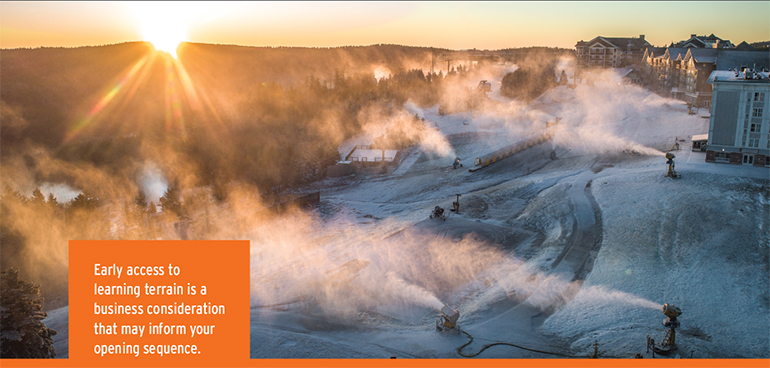
Infrastructure discussions eventually become largely a matter of math and money. There are only so many ways to deliver water at sufficient pressure to the top of your mountain, for example, and if your business plan calls for this but the financials don’t check out, you will need to re-assess your plan.
PRODUCTION
Assuming you have the infrastructure to support the overall targets, the primary considerations in master planning or upgrading a system are the equipment (snow guns) and your temperature bins (periods when the temperature dips into snowmaking range). Focus your analysis on flow curves—specifically, the relationship between the wet bulb temperature, water pressure + water temperature, and a snow gun’s flow rate (GPM).
Other important variables include the gun’s effective conversion rate (gallons per acre-foot of snow), typical wind levels and direction at the gun’s specific location to estimate the amount of snow that will be lost off-trail, and the gun’s “step function”—an important point in the topic of automation.
Plug this data into your historical weather patterns and temperature bins to understand effective production capacity. You can be as basic or as detailed as you want in this analysis. Remember, the goal here is to procure the right equipment to deliver on the opening targets, which are primarily flow driven.
We were exceptionally detailed at Snowshoe, modeling production at every single hydrant based on a multitude of factors: temps, pressures, sun/shade, wind, trail dimensions, ground temps, etc. But even basic analysis will help you figure out generally what will and will not work. For example, if your goal is to open by Thanksgiving each year, but November typically brings only 75 hours of sub-30° F and more than 200 hours of above-50° F, you are probably not going to make it with guns that present flow-curves of 15 GPM at 25° F.
PRODUCTION: TO AUTOMATE OR NOT TO AUTOMATE?
Automation is a matter of production versus execution. If you can make automation work well, you will make more snow than any manual system could—but that outcome is not automatic.
There are two major benefits driving automation: on/off-time and flow-curve smoothing.
On/off time. At Snowshoe, we measured the fastest and slowest on/off times for our manual guns, racing to time them with the temperature bins. The first guns were on just as wet bulb temps reached thresholds, but the last guns were on more than an hour later. This often meant that the average manual gun waited 30 minutes or more to be activated—critical time to lose with shrinking snowmaking windows and business-crucial opening objectives. The same applied to turning the guns off prior to temperatures rising above snowmaking thresholds.
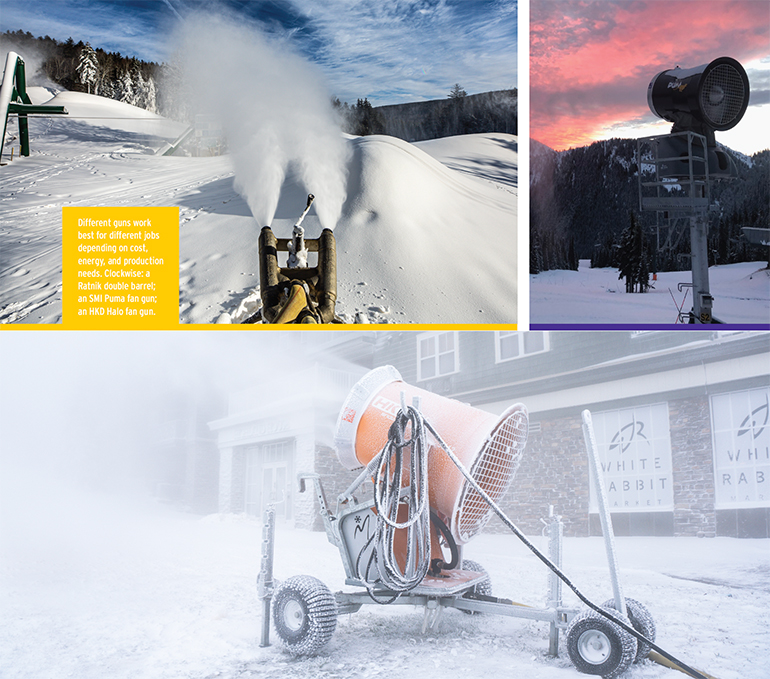
In all, one to two hours of lost production per eight-hour window is a 12.5 to 25 percent reduction in effective on time. You can do the math on what that means for your snowmaking.
If your location requires that you live or die by marginal snowmaking and small windows, automation should be a strong consideration.
Flow-curve smoothing. Flow-curve smoothing is simply the effect of a fully-automated gun that has the capability to smoothly increase water flow as temperatures drop, and vice versa. In comparison, a manual gun stays at the flow stage it was set to until a snowmaker returns to adjust it later in the night.
If it takes two hours for a snowmaker to return to a gun and the temperature decreases from 27° F to 21° F in that time, with the gun operating at its reduced flow set for 27° F, this could easily be a third or more of its potential snow production in opportunity cost. That subpar flow-curve, combined with the time lost on manual on-off, could mean only half of the total potential snow production was realized that night.
Of course, this all assumes automation runs without issues, which isn’t always the reality.
EFFICIENCY
Efficiency refers to both the upfront monetary investment and ongoing energy cost and sustainability. To some extent, efficiency will need to take a backseat to production—it does little good to have a highly efficient system if it doesn’t produce enough snow to open. A system must achieve the required flow rates within the necessary timeframes to satisfy the business objectives. Otherwise, consider scaling back your efficiency targets and going with either more costly or more consumptive equipment that can produce more snow, faster.
With snowmaking equipment, one must strike a balance between upfront cost, production, and efficiency.
Put simply, traditional air-hogs are typically the least efficient from an ongoing energy-consumption perspective, but highly efficient from an equipment cost to production perspective: They are inexpensive to buy and will reliably make snow in any conditions, but they use a ton of energy. The latest automated fan guns typically provide the greatest production with relatively moderate ongoing energy consumption, but at the highest upfront cost. Low-energy sticks are highly efficient in long-term energy usage, but produce less snow at marginal temps, and are usually more expensive than traditional air-water guns.
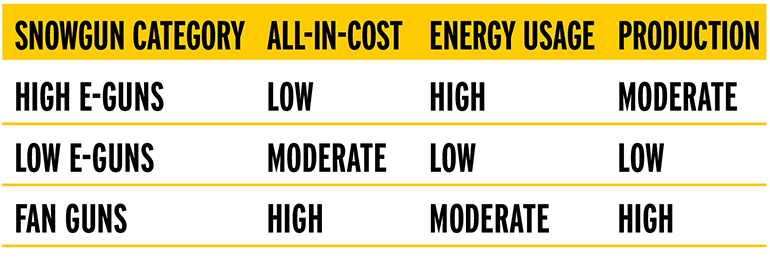
There are also infrastructure considerations. For example, converting a big portion of your fleet from air hogs to low-e sticks or fans will not necessarily lower your electric bill unless your air compressors stay off to avoid setting your peak demand and to reduce overall energy consumption. Other considerations include pump and compressor VFDs, power factor correction, conversion from diesel generation to electric, and more.
Ultimately, efficiency is a mix of financial and energy considerations and their tradeoff against “paying for better.” More efficient equipment is typically more expensive up front, but will provide some return over time.
BACK TO BUSINESS
Connecting these elements, it is then important to re-apply the financial and business case. Whatever you land on with respect to the system and master plan, bring it full circle.
For example, if your primary goal is to hedge against warm weather, it might make sense to invest in the costliest “insurance policy” money can buy. In other cases, resorts may have a more forgiving climate, allowing for superior cost and energy efficiency without sacrificing the ability to meet business objectives.
Assess whether you really need that fancy automated maximum-production system or those manual air-hogs or low-e sticks. What will this do for skier visits and the bottom line? What about the ability to quickly resurface and groom, and its impact on the guest experience, return visitation, effective ticket price, etc.? What about the decision to open two weeks earlier than usual—is it worth it? What about making snow on multiple trails during a tough marginal opening sequence rather than focusing all resources on key opening trails—are you taking too much risk?
Analyzing and understanding how your system will handle all of these scenarios, and more, is critical to proper planning and execution to ensure predictable financial and business outcomes.
THE PEOPLE FACTOR
Perhaps the most complex part of this equation is the people. Specifically: ownership, management, and ops personnel.
Ownership must be on board with any investment, financial commitments, and outcomes; management needs to craft, analyze, validate, and resource (empower) the business case; and ops needs to execute. Each of these links in the chain are equally important. A breakdown at any point could be detrimental to the success of the pursuit, or at the very least, result in subpar outcomes.
Owners are often investors. And, like investors, when things are not going well, they are quick to look for means to protect their investment. On the flipside, when things are going well, success hides many shortcomings, and the importance of hedging (or the idea that things could/should be done better) can fade.
Management, on the other hand, being somewhat closer to reality on the ground, is less prone to this vacillating mentality, but still often loses focus on snowmaking strategy amid the flurry of other functions involved in ski area operations.
Operations people and snowmakers are entirely aware of the criticality of snowmaking and are the thread by which the resort’s business hangs, but they are rarely consulted by management in business planning efforts and often end up siloed.
In the end, management bears the burden of aligning these perspectives. To gain the buy-in of ownership, management must prove out the business case and ensure the snowmaking plan supports the ski area’s strategy. To gain the buy-in of snowmakers—a group you will not win over by simply telling them what to do—they need to be part of the discussion. Additionally, management must get their boots wet and understand the challenges snowmakers face daily and how to manage through the growing pains of integrating new tech.
WORTH THE EFFORT
It takes time and effort to align your snowmaking strategy and master plan with your ski area’s business plan. Since you’ve read this far, you know there are myriad elements to consider—and there are even more considerations that are unique to your property, people, existing infrastructure, resources, and goals. The outcome is worth the effort, though.
Don’t let a good snow year impede your progress, either. When things are going well, you probably won’t notice what you’re missing. When things are going poorly, you will wish you had started planning sooner. Complacency is the enemy of progress. Being proactive pays dividends in the long term.
This has proven true for Snowshoe. Since its methodically planned snowmaking overhaul debuted four years ago, the resort has achieved consistently record business levels and profitability and maintained its terrain opening guarantees. Of course, this success is not due solely to snowmaking, but it has played an outsized role. And the investment has paid for itself many times over. The intangible benefits on the guest experience are not to be understated either.
If there’s hope for one small Southeast resort, there might be hope for the entire industry.





